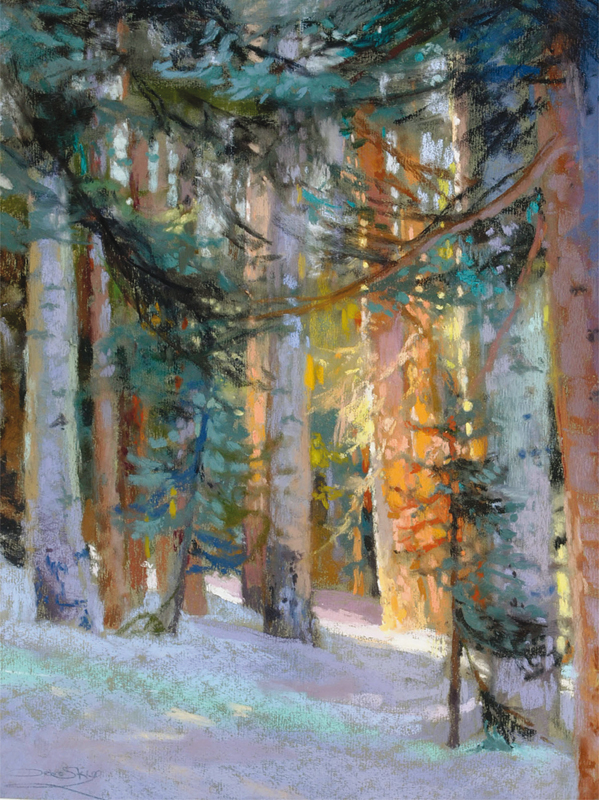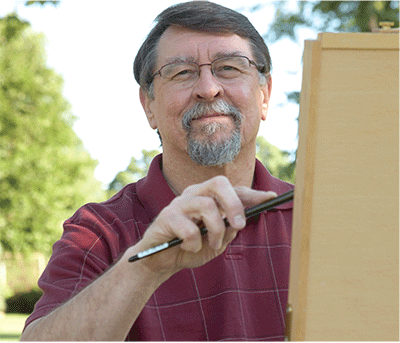
1⁄2-inch (13mm) Gator board, acid-free foamboard, Ampersand Gessobord, Arches Oil Paper, canvas, Jack Richeson gessoed hardboard, linen canvas, medium-density fiberboard, panel, sanded pastel paper, Sennelier La Carte pastel card (charcoal colored), UArt 400-grit sanded paper
Raw Umber, Titanium White
Alizarin Crimson, Alizarin Permanent, Asphaltum, Burnt Sienna, Burnt Umber, Cadmium Green, Cadmium Lemon, Cadmium Orange, Cadmium Red, Cadmium Red Deep, Cadmium Red Light, Cadmium Red Medium, Cadmium Red Orange, Cadmium Yellow, Cadmium Yellow Deep, Cadmium Yellow Light, Cadmium Yellow Medium, Cadmium Yellow Pale, Carbon Black, Cerulean Blue, Cobalt Blue, Dioxazine Purple, Flake White, French Ultramarine Blue, Ivory Black, Lemon Yellow, Manganese Blue, Manganese Blue Hue, Naples Yellow, Naples Yellow Light, Olive Green, Payne’s Gray, Permanent Alizarin Crimson, Permanent Green, Permanent Green Light, Permanent Rose, Phthalo Blue, Phthalo Green, Quinacridone Burnt Orange, Quinacridone Gold, Quinacridone Rose, Quinacridone Violet, Raw Sienna, Raw Umber, Raw Umber Violet, Sap Green, Terra Rosa, Titanium White, Transparent Orange, Transparent Oxide Brown, Transparent Red Oxide, Turquoise Blue, Ultramarine Blue, Ultramarine Blue Deep, Utrecht White, Van Dyke Brown, Viridian, Viridian Green, Yellow Ochre, Yellow Ochre Pale, Zinc White
Alizarin Crimson, Bismuth Vandate Yellow, Burnt Umber, Burnt Sienna, Burnt Umber, Cadmium Orange, Cadmium Red, Cadmium Yellow, Carbon Black, Diarylide Yellow, Hansa Yellow Opaque, Mars Violet, Naples Yellow, Payne’s Gray, Phthalo Blue, Pyrrole Orange, Pyrrole Red, Quinacridone Magenta, Raw Sienna, Raw Umber, Red Oxide, Sap Green, Titanium White, Transparent Viridian Hue, Ultramarine Blue, Van Dyke Brown Hue, Yellow Ochre
#305 Spruce Blue NuPastel, Cretacolor Pastel Carré hard pastels (72-color set), Great American Art Works pastels, Pastels Girault, Rembrandt pastels, Sennelier Half-Stick soft pastels (80-color set) Terry Ludwig pastels
liner: no. 2
brights: nos. 1, 2, 4, 6, 8, 10, 12
rounds: nos. 00, 01, 0, 2, 3, 4, 8, 10
egberts: nos. 2, 4
filbert bristles: 1⁄4-inch (6mm), 1- to 11⁄2-inch (25mm–38mm), nos. 0, 1, 2, 3, 4, 5, 6, 8, 10, 12, 14
fans: 1-inch (25mm), nos. 6, 12
flats: 1⁄4-inch (6mm), 1⁄2-inch (13mm), 3⁄4-inch (19mm), 1-inch (25mm), 2-inch (51mm), 3-inch (76mm), nos. 1, 2, 3, 4, 5, 6, 8, 10, 12, 14, 16, 20
400-grit sandpaper, alkyd medium, burnishing tool (bone folder, back of spoon, ice pop stick), charcoal pencil, citrus thinner, Cobra glazing medium, Cobra painting medium, cotton swabs, easel, foam makeup applicator, freestanding light stand with 100- to 150-watt bulb, freezer paper, Gatorfoam drawing board, gel medium, glass palette, glass scraper, gray paper palette, latex gloves, light- to medium-grade sandpaper, linseed oil, man-made objects (vases, old bottles, vessels, books, toys, decorative boxes, tables, tablecloths, household items, other uncommon objects), masking tape, medium- to coarse-grit sandpaper, mineral spirits, natural objects (flowers, food, fruits, vegetables, leaves, sticks, nests, eggs, animal skulls), neutral gray Plexiglas palette, odorless mineral spirits or denatured alcohol, palette knives (1-inch (3cm), 21⁄2-inch (6cm), 3-inch (8cm), 31⁄4-inch (8cm) triangular-shaped), paper palette, paper towels, pencils (H-4B, 6B), rags, sketch paper or sketchbook, slow-drying medium, soft gel medium, soft lead pencil, soft vine charcoal, solvent-free gel medium, spray fixative, spray retouch varnish, toothbrush, toothpicks, tracing paper, traditional oil ground, turpentine, umbrella, vine charcoal, walnut oil, water, white gesso, white glue, wooden stick, workable fixative
Using the right tools and materials in the correct way can make a big difference in the success and enjoyment of your artistic process. The following pages outline many of the options at your disposal so that you can make the most of your art materials, your time in the studio and your spirit of creative adventure.

Christine Debrosky’s finishing strokes are like a delicate dance across the sanded paper surface. She adds small spots of intense color to achieve the sense of dappled light.
Aspen and Hemlock Lace
Christine Debrosky
Pastel on Wallis Belgium Mist
14" × 11" (36cm × 28cm)

Having a conversation with Ed Brickler is like opening up an encyclopedia. This man is a fount of artistic technical knowledge. Not only is Ed a working artist, he is also the Director of Fine Art Education for Canson, Arches, and Royal Talens. When he is not in his studio painting, Ed is busy traveling the country and demonstrating for most of the major art materials companies.
Ed understands that materials matter in order to successfully execute a painting. Because of this, Ed has compiled his extensive knowledge of art materials into the popular book Making Art: Materials and Techniques for Today’s Artist (North Light Books). Ed was kind enough to share tips from his book in the following pages. This information was selected to suit the needs of the aspiring and professional fine artist. Parts will be a refresher course to some, but many of you will also find valuable information on new art materials and mediums.
The materials information in this chapter is reprinted from Making Art: Materials and Techniques for Today’s Artist with the kind permission of Ed Brickler and North Light Books. Purchase a copy of Making Art at your favorite bookstore or online retailer.